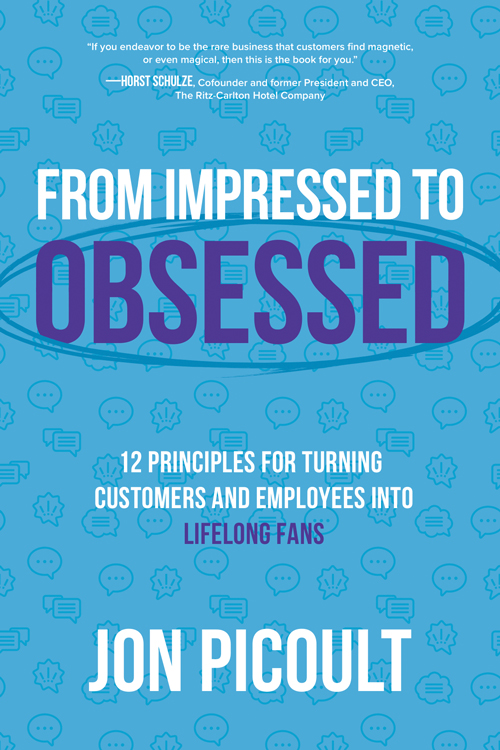Jon Picoult is a renowned expert on customer experience and the author of “From Impressed to Obsessed: 12 Principles for Turning Customers and Employees into Lifelong Fans”.
 By Stephen Shaw
By Stephen Shaw
You would think by now that just about every company would have accepted the necessity to deliver an exceptional customer experience.
Apparently not, according to Forrester Research.
Forrester’s latest Customer Experience Survey found that CX quality has fallen for an “unprecedented” third year in a row. In fact, average CX quality has dropped to its lowest point since 2016. “US consumers are having, on average, the worst experiences in a decade,” explained Rick Parrish, VP and research director at Forrester. “Brands want to create better experiences, and they realize that putting the customer at the center of their business is the way to do it. However, organizations struggle with the scale of change that this requires.”
Forrester also conducts Net Promoter Score rankings for 100 brands in Canada and the most recently published report mirrored the CX findings: the NPS score dropped or remained the same for all industries last year. In commenting on the NPS results, Parrish stated what every consumer already knows: “In Canada, brands are struggling to provide effective, easy, and emotionally positive experiences for customers”. He went on to say: “When brands put customers at the center of their leadership, strategy, and operations, they enable stronger customer loyalty – which in turn drives revenue, profitability, and business resilience, even in uncertain times.”
All too true. Strangely, that linkage between loyalty and profitability seems to have escaped the notice of most CEOs.
Treating people with respect – showing appreciation for their business – making their lives easier, more productive, more rewarding – minimizing their level of effort – being a company that cares about customers after the sale as much as before – all of that goes a long way to securing greater brand loyalty. Yet most companies get a failing grade when evaluated against those basic principles. It seems companies are headed in the opposite direction, prioritizing profits over people. Customer service is seen as a cost – which explains the rush to adopt AI-powered chatbots meant to take over from live agents. It also explains why it can be so hard to find a phone number to call if you have a question or complaint.
Today more than ever customers are feeling shafted, exploited, taken for granted. And their simmering resentment over complaint handling is spilling over into angry confrontations with front line workers, according to the 2023 U.S. National Customer Rage Survey. “The incidence and public displays of customer rage are commonplace, on the increase and can be scary”, the report observes.
Corporate mistreatment of customers is baffling when you consider that repeat buyers almost always account for a disproportionate share of total sales and are the only sustainable source of recurring revenue. As long as the experience a brand offers is indistinguishable from competitors, it is substitutable, and doomed to compete on price.
Marketing has to shoulder some of the blame for this corporate apathy toward CX, too busy chasing market share to give much thought to expanding “share of heart”. Certainly most CMOs appreciate the importance of delivering something other than a “me-too” experience even if company leadership does not. It’s just that most marketers struggle to be seen as “serious people” capable of serving as change agents, even though their job is to make an emotional connection with people. And according to renowned CX expert Jon Picoult, the transformation of customer experience starts with understanding how people feel.
 To create genuinely loyal customers – emotionally committed customers who love the brand, who will go out of their way to buy it, who are true fans, who are quick to forgive and to recommend – Picoult believes it is essential to deliver a more “memorable experience”. In his book “From Impressed to Obsessed” he offers 12 principles for turning customers into “lifelong fans”, derived in part from insights into how the mind works from the field of cognitive science where he gained his university degree.
To create genuinely loyal customers – emotionally committed customers who love the brand, who will go out of their way to buy it, who are true fans, who are quick to forgive and to recommend – Picoult believes it is essential to deliver a more “memorable experience”. In his book “From Impressed to Obsessed” he offers 12 principles for turning customers into “lifelong fans”, derived in part from insights into how the mind works from the field of cognitive science where he gained his university degree.
STEPHEN SHAW (SS): What drew you to the field of cognitive science?
JON PICOULT (JP): The thing I had always been interested in at university was getting computers to mimic human thought. This was 25 or 30 years ago, and people had been promising AI for years. My focus was understanding how the human mind interprets language and then getting computers to replicate that. And I have to admit, I never expected that I would use my cognitive science degree in the way that I have. Because today it’s central to my philosophy, the notion of how you sculpt memories and customer experiences.
SS: What made you decide to focus on CX as a discipline?
JP: In my financial services career, I ended up leading not just customer service, but also marketing, operations, distribution, sales, and even IT, at one point. I had an opportunity to see how the customer experience was being engineered and delivered from several different perspectives. Customer experience was something I was always passionate about. And I felt I had some credibility, having served in all of those different functional roles. And where I recognized many companies go wrong is they don’t realize that each functional silo is working at cross purposes and not coalescing around a common vision of the experience.
SS: When you started down that path 15 or so years ago was there a groundswell starting to form around CX?
JP: Back then, if you said customer experience to someone what they heard was customer service. Even today, I find that’s a challenge with many organizations. It is still unusual to come across a C-suite that views customer experience as more than just the initiative de jour. I think that many CX efforts are corporate window dressing. It’s a box to be checked. And so I absolutely believe that there is still a lot of missionary work to be done for senior leaders to really understand not just the value and the ROI of customer experience, but also just what the term means, and that it’s fundamentally different from customer service.
SS: In its recent annual CX assessment of different industries Forrester Research reported that quality has hit a new low and has declined for the third year in a row. What do you think are the main factors behind this trend? You’d think things would be getting better, not worse.
JP: Fundamentally, the issue is that there are two types of CX strategies – you either focus on maximizing loyalty or you focus on minimizing attrition. And those are two very different strategies. Maximizing loyalty is about trying to figure out how do I enrich the lives of my customers. How do I create that emotional connection? How do I turn them from “impressed to obsessed”? But if the strategy is minimizing attrition, as it is for most companies, what they’re asking themselves is, what’s the minimum amount that we can do that will keep people from leaving us? And that’s a very different strategy. If you look at your retention numbers, if you look at your financials, you might say, okay, we’re striking the right balance. But I think that’s short-sighted. It might deliver short term profits, but I don’t think it’s a long term solution. That’s why customer experience is not improving across the board.
SS: It seems to me that most companies view customer service as a cost, not as an investment in the relationship. And that is abundantly clear in a recent New York Times article on Amazon whose clear intention is to automate as much of customer service as possible to take cost out of the business.
JP: One thing I would say about Amazon – and I haven’t read that Times article – but they look for ways to make the experience not only more pleasant, but also more efficient. And a key way of doing that, of course, is automating things. And if a company can solve a customer’s problem without having them to talk to a live rep, that’s going to be their preference.
One thing I would say about Amazon is that they are a company that has been very thoughtful about how to introduce automated and self service capabilities. As a consumer, I encounter a lot of chatbots that just have me ripping my hair out. I had one just this morning with my cable company, one of the most hated companies in the country. I was boiling over with anger. I have to contrast that with Amazon: I think they’ve been very clever about how they have structured their chatbots. One thing I think Amazon’s done well is triaging in an automated way to direct people to the service channel that’s best for them.
SS: Here in Canada there are some truly abysmal companies whose underwater NPS scores don’t seem to trouble them at all because they’re making out like bandits. You’ve got the telcos, the banks, the cable guys, the national airlines, for sure, with the exception of a company called Porter. If you were talking to their respective boards today, what would you say to them?
JP: What I would tell the C-suite at those companies, or their boards of directors, is you need to look at the annals of corporate history and see that it is littered with the carcasses of companies that were dominating their markets, that didn’t think they needed to invest and improve their customer experience. And then what happened? Some new company figured out a better way to serve the customer and ate their lunch accordingly. Eventually, if you are truly delivering a mediocre experience to your customers, you are ripe for disruption by new entrants. The party eventually ends.
SS: I think part of the challenge here are oligopolies that have a stranglehold on the marketplace. You certainly see that in the grocery business here in Canada.
JP: We as consumers also bear some responsibility for encouraging the behaviour you’re talking about, because we are lazy creatures at heart. And this is what companies count on. Companies count on consumers not investing the time and energy to research an alternative, to transition to another cable company or some other insurance provider or bank. So we as consumers need to make sure we vote with our feet. You need to overcome what is an inherent human quality to take the path of least resistance by sticking with your current provider, even though you hate them, because they’re just not bad enough to make you invest the time to go elsewhere.
SS: One the key concepts in your book is the idea that’s it’s important not just to create a satisfied customer, but to create a memorable experience. Smart companies, you say, are in the business of shaping customers’ memories. What people remember are the peak experiences. Can you just elaborate on this theory, which I think is drawn from cognitive science, is it not?
JP: The whole idea that you’re talking about is this notion that what great companies recognize is that they’re not just in the business of shaping people’s experiences, they’re in the business of shaping their memories. And indeed, I would argue that how people remember their experience with a business is even more important than the experience itself.
An experience doesn’t play back in our memory like watching a video. That is not how it works. We remember experiences as a series of snapshots. And it’s not just any snapshot that we remember. Where the camera shutter clicks is during the peaks in the experience — the high points — and during the valleys in the experience — the low points — and then also at the last thing that happens to us. That’s what gets cemented in our memory. The last thing that happens to us in any interaction exerts a disproportionate influence over our perceptions and memory of that interaction. So that’s what I’m talking about when I discuss the psychology and the memory science behind customer experience. Because what I think great companies do is they understand these principles and they work very thoughtfully and deliberately to sculpt people’s perceptions and memories.
SS: If you have an equal number of good and bad experiences, is it effectively a wash?
JP: Not really. What happens is the things that are going to exert greater influence happen towards the end. If there are valleys, you just want to make sure that they are predominantly not happening in the latter half of the experience. Because again, just the way our memory works, if you have an equal number of peaks and an equal number of valleys, if the peaks are happening towards the end, that’s going to carry the day, and in some, that’s going to elevate the impression rather than deflating it.
SS: You state that how a customer feels about the experience is really what matters. Is that something you can actually design for in advance? Can you actually design the experience to drive feelings of joy, or relief, or exuberance?
JP: Absolutely. One of the twelve principles in the book is about stirring emotion. You might remember in the book there was a company called Framebridge. They’re an online service for framing photos or memorabilia. And my son used them one day to frame a picture, a gift for his grandparents of a photo he had taken of some mountains in the Berkshires in Western Massachusetts. He got the package back with the framed photo, and there was this personalized, typewritten note in it, which clearly indicated that somebody had looked at the photo. And the note said something like, we love your photo, we can just feel the clear, crisp mountain air, and I mean they frame hundreds of thousands of pieces of photos and artwork every year. It was clear that this was a personalized note. Talk about memory making. Because there’s an element of surprise there. There’s an element of reassurance. So, yeah, absolutely, I think that you can, by design, create an experience that is emotionally resonant.
SS: We do satisfaction and loyalty studies for some of our clients and one of the anomalies we regularly see is if a product complaint or warranty claim is satisfactorily handled, that person ends up being more loyal than the average customer. There’s a term for it that you reference in the book: the Service Recovery Paradox.
JP: Yeah. So if you go back to that principle about the recency bias and making sure you finish on a high note, what that really indicates is that if there is an issue, like a warranty claim, if it is handled really well, you have the opportunity to create a peak at the end of the experience that actually eclipses the negativity of the product failure itself. It’s just the way our memories work. If you over rotate on that recovery, in this case, the warranty claim, that’s what people are going to remember, and that will dissolve from their memory that they even had to make a warranty claim in the first place. You can actually create a more loyal customer after the recovery than what you had before the failure.
SS: Which ones of your twelve principles are in your view the most critical to getting the customer experience right?
JP: I’m going to highlight three. The first one, I would say, is the idea of making it effortless for customers. I said to you a little earlier, we are lazy creatures at heart. That is just human nature. Oftentimes it’s not the best product or service that wins in the marketplace. It’s just the one that was easiest for people to access and utilize. Making the experience effortless is a really effective way to endear yourself to your customer, because customers’ most valuable, finite resource is their time. And when you make it effortless for them, you are giving them the gift of time and convenience, and in return, they’ll reward you with their enduring loyalty.
The second one I would call out would be the idea of stirring emotion. And we talked about this already. I quote in the book, Jonathan Haidt1, who’s a famous social psychologist and professor at NYU, who once said that the emotional tail wags the rational dog. Because customer perceptions and memories of an encounter are influenced by how they feel after that interaction. If every time you call a company, you’re made to feel like you were a burden on that service rep, if you were made to feel unvalued, or uninformed, or dumb, or embarrassed in some way, it doesn’t matter that they pick up the phone in 10 seconds flat, you’re still going to walk away with a negative impression. So that’s why the emotion piece is so critical.
The third one that I would highlight for you, which I have to admit that I love a little bit more maybe than the others, is the notion of giving your customer the perception of control. The reason I love this one is because it often costs nothing, yet it has such a significant impact on the impression that you leave on your customers. Again, this goes back to psychology. We, as human beings, like to be in control of what’s going on around us. We are control freaks at heart.
If people are made to feel like they have control over the experience, they will feel better about that experience. It’s almost magical that way. And I think the classic example of this is the difference between a known wait and an unknown wait. When you get into line, and you’re told the approximate wait time, that feels like a very different experience than if nobody says anything to you. Because when you don’t have your expectation set, you are wallowing in ambiguity. And when you’re wallowing in ambiguity, you feel like you’ve lost control of what’s going on around you. Just by setting an expectation of a wait time totally changes the experience.
SS: As you know, the way a lot of companies are trying to eradicate pain points is through customer journey mapping. You’re not a big fan. I’m curious why that is.
JP: I think that it is a tool that is suitable in certain instances, such as helping to give people in an organization a better idea of how the experience actually unfolds and how the typical customer feels at each stage of that experience. So I’m not saying it’s not without value. However, the issue that I’ve got with customer journey mapping is that it is typically done at a 30,000 foot level, meaning that you get a bunch of people in a room and there are post it notes and there’s a big poster board, or there’s a big wall where you’re kind of drawing out this graphical visual illustration of the customer journey, and you’re mapping what you think are the high points and the low points. And one key miss is that many companies never involve customers. You could do it, but you would come up with a whole bunch of conclusions that you’re going to throw out once you inject the customer perspective. So the way people go about journey mapping is just navel gazing, and it often has important blind spots. The hearts and the minds of your customers are not won at 30,000 ft. Traditional journey mapping exercises don’t go deep enough, in my view, to reveal some of the minutiae that can have a very significant impact on the impression being left on your customers.
SS: I want to touch on another key area which is measurement. What’s on your ideal CX dashboard?
JP: I think that many CX practitioners are almost religious in their zeal for a particular metric, and I think that’s dangerous. Every metric has pros and cons, and I think that it’s important to acknowledge that. Personally, do I think Net Promoter is a good measure? Absolutely. I like it, and I probably favour it over a standard CSAT measure. But the reason I say that is because I think that Net Promoter, when implemented correctly, can be a very effective tool for helping to shape a culture. But I would never tell anyone, hey, it’s NPS or nothing. That I think is crazy. The key is you just need to make sure that there is a formal, institutionalized and disciplined approach for continuously soliciting the input of your customer. And that voice of the customer program should not be limited to just surveys. I think there are other instruments that the company should be using to make sure they’re keeping their finger on the pulse of the customer.
SS: What does an optimal organizational structure look like to support end-to-end CX?
JP: Some of the most successful setups I’ve seen are dependent not on the function, but rather on the person. And here’s why I say that. People who are successful in a CX leadership role within an organization have a very unique set of skills, in my view. It’s a unique balance of right brain and left brain. You could give CX to a marketer, and they could come up with all kinds of great ideas, but they might struggle with execution, they might struggle with practicality, and so that doesn’t get you anywhere. Now, conversely, you could give it to an operations person, and they might be great at execution and practicality, but they might be limited in terms of thinking, “How do I bring the brand to life in every interaction?”. Which the marketer would be able to do effectively. So I find that the people who really succeed in these roles are the ones who can easily skate across those different domains. And the fact is, those people could live anywhere in the organization. I think you’ve got to ask yourself, who’s the person on my team that is best suited to build relationships with their peers? Because let’s face it, that’s a really tough challenge for anyone in a CX role. You need to be an influencer with the heads of all the different functions – somebody who can earn the respect of the head of sales, of the head of service, of the head of distribution, of the head of IT.
SS: Assuming a company wants to become customer centric, who should be accountable for driving that change?
JP: The answer I would give you is executive-level commitment. There is simply no substitute for having a CEO or a President or some other member of the C-suite who is just inherently passionate about this topic and believes it in their bones. Because that’s how you start to get away from the initiative de jour pitfall. It’s not a surprise that you often find that in founders of companies. I mean, this has to be woven through the organization, and there’s no better person to do it than the person who’s at that C-level. Might that C-level individual choose to hire a head of customer experience to spearhead things? Yes, and that might be the right answer. Might there be a steering committee? Yes. But ultimately it’s that C-suite individual, because that’s the person who’s going to look the head of IT in the eye, the head of legal in the eye, the head of service in the eye, the head of sales in the eye, and have the tough discussions with them to make sure they are working to optimize the end to end customer experience.
SS: And the CEO is the one who has to convince the board.
JP: When I launched Watermark in 2009, I said to myself, hey, what language does the board understand? What language does the C-suite understand? And the language that they understand is the language of shareholder value. Whether you’re a public or private entity, that is a language everybody understands. And that’s when I said to myself, hey, wouldn’t it be interesting to take a look at the shareholder returns of the publicly traded companies to compare the best and the worst in customer experience. And from that was born the Watermark CX ROI study2, which we’ve updated every few years now, and there’s a new one coming out actually later this summer. The companies that lead in customer experience outperform those that lag by over three to one in shareholder return. And that’s for, I think, a 13 year period. To me, that’s the exclamation point on the case for customer experience. What that study really shows is that the return from a great customer experience is not soft and intangible. It is real, it is material, and you can take it to the bank.
- Jonathan Haidt is an American social psychologist whose area of study is moral foundations theory which deals with the origins of human moral reasoning.
- The Watermark Customer Experience ROI Study is based on the cumulative total stock return of Customer Experience (CX) Leaders and Laggards as identified by third party CX rankings.
Stephen Shaw is the Chief Strategy Officer of Kenna, a marketing solutions provider specializing in delivering a more unified customer experience. He is also the host of the Customer First Thinking podcast. Stephen can be reached via e-mail at sshaw@kenna.ca



